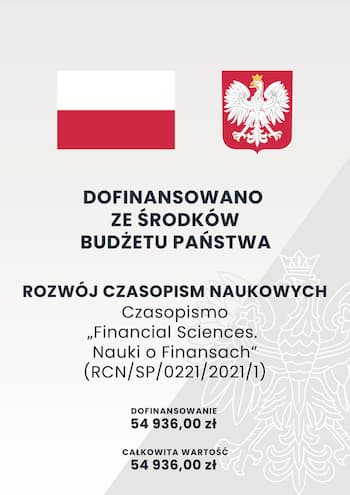Issues
Click a year to expand it.
40 Points
on Ministry of Education and Science journal evaluation list of 2024

Search results for query: Filipiak
Sort by: Relevance Author: Ascending Descending Year: Ascending Descending
- Risks in the investment activity of Polish regions
Author: Beata Zofia Filipiak, Marek Dylewski
See Issue Contents: fins.2018.4
Abstract:Investment activities executed by regional authorities are exposed to high risk. The risk results from the very essence of investment projects implemented by regions in Poland and can be associated with the failure to meet the regional budget. The purpose of this study is to assess the size of the existing discrepancies between the planned and actually incurred investment expenditure and to find out if there are systematic changes in the level of these discrepancies i subsequent years. This goal was achieved through the presentation of the specific approach to risk measurement in the investment activities of local government units. The research was undertaken by regional self-government units. Empirical research has allowed us to answer three research questions: how great were the disparities between the planned and the actually incurred investment costs in the Polish regions in 2011-2015? Did systematic changes in the level of inconsistency between the planned and the actually incurred costs take place in the observed period? Was the rate of failure to meet investment plans correlated with the rate of failure to meet operational financial plans?
- Regulations of the financial market in Poland. Equilibrium vs. inversion
Author: Leszek Dziawgo, Danuta Dziawgo
See Issue Contents: fins.2018.4
Abstract:The subject of this study is the legal regulations concerning the banking and stock market sector. The research objective is to identify the issue of the adequacy of legal regulations on the modern financial market. The object of the research is the banking institutions and companies listed on the stock exchange. The following research methods were used, i.e. the analysis of the literature, analysis of legal acts, observations, descriptive, comparative and case study analysis. It was found that there has been an increase in the level of detail and restrictiveness of legal regulations in recent years, both in relation to the banking sector and to the stock market. In addition, the legislative revolution not only continues, but is also gaining momentum. Thus we could formulate a conclusion about the inversion of the modern financial market. The financial market was to facilitate business operations through access to capital. Currently, excessive regulations indicate the growing legal barriers to entering the financial market and conducting business activity in it
Newsletter






